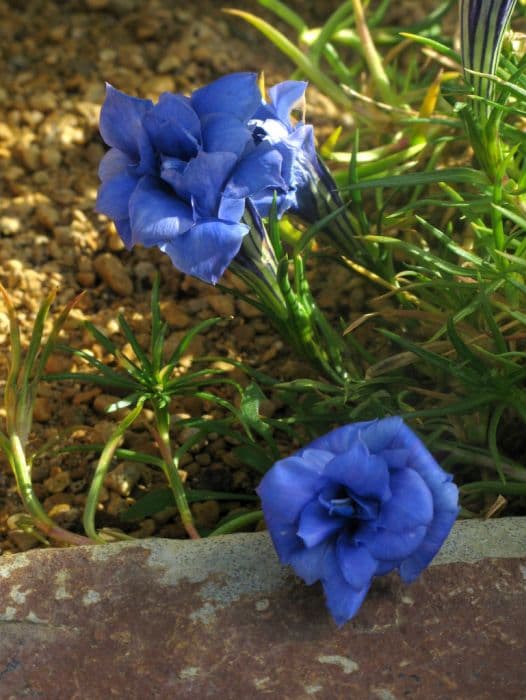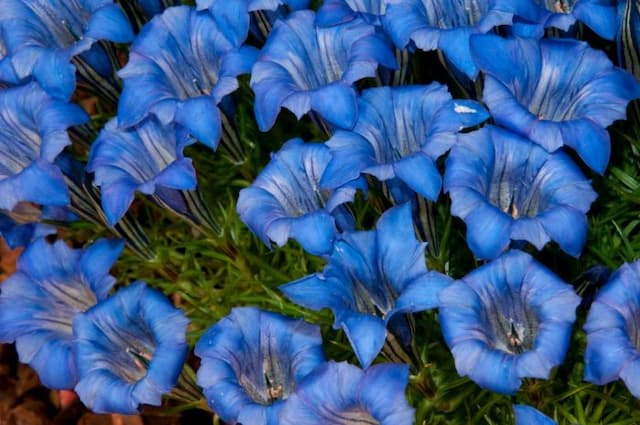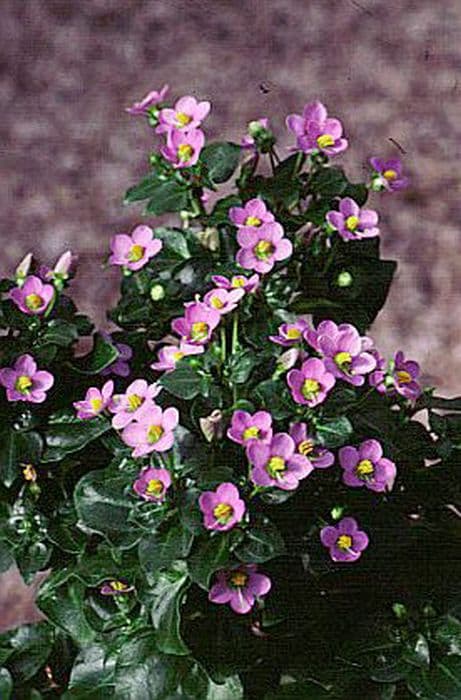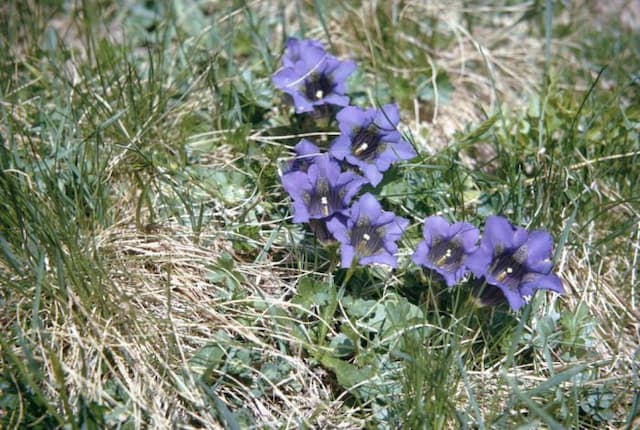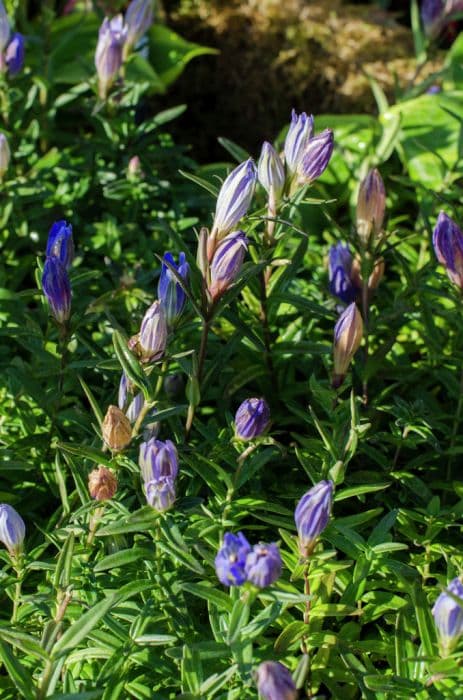Pointed-Flower Gentian Gentiana paradoxa

ABOUT
Gentiana paradoxa, commonly known as the paradox gentian, is a striking and distinct perennial plant. It produces stems that hold up captivating, bell-shaped flowers. These flowers typically boast a deep, rich blue hue that can occasionally appear with lighter blue or white streaks. The contrast of the vibrant blue against the green foliage makes for an eye-catching display. The leaves of the paradox gentian are lance-shaped, providing a slender and pointed appearance, and grow in an opposite arrangement along the stem, creating a lush green backdrop for the vivid blue flowers. This arrangement of leaves is quite neat and organized, adding to the aesthetic appeal of the plant. The stem itself is sturdy, supporting the weight of the flowers and allowing them to stand out prominently. This gentian variety is known for its ability to thrive in cooler temperatures, which is often reflected in the refreshing coolness of its blue flowers. Its preference for a specific range of conditions, including well-drained soils, makes it a unique choice for gardens looking to add a pop of color. Overall, the paradox gentian's appearance is characterized by the harmony of its striking blue flowers, paired with its elegantly shaped leaves and structured growth form. It is much appreciated in garden settings for its exceptional and vivid coloration that adds depth and intrigue to plant compositions.
About this plant
 Names
NamesFamily
Gentianaceae
Synonyms
Pointed Flower Gentian, Paradoxical Gentian
Common names
Gentiana cruciata var. paradoxa, Gentianella paradoxa, Gentianopsis paradoxa.
 Characteristics
CharacteristicsLife cycle
Perennials
Foliage type
Deciduous
Color of leaves
Green
Flower color
Blue
Height
1-2 feet (30-60 cm)
Spread
1 foot (30 cm)
Plant type
Herb
Hardiness zones
4
Native area
Caucasus
Benefits
 General Benefits
General Benefits- Ornamental Value: Gentian paradoxa is known for its striking blue flowers, which can be a visually attractive addition to gardens and landscapes.
- Biodiversity Support: It provides nectar for pollinators such as bees and butterflies, supporting local ecosystems.
- Soil Stabilization: The root systems can help prevent soil erosion in certain environments.
- Tolerance to Harsh Conditions: Gentian paradoxa can survive in poor soil conditions and at high altitudes, requiring minimal care once established.
- Seasonal Interest: Its blooming season adds a splash of color to gardens when many other plants may not be flowering.
 Medical Properties
Medical PropertiesThis plant is not used for medical purposes.
 Air-purifying Qualities
Air-purifying QualitiesThis plant is not specifically known for air purifying qualities.
 Other Uses
Other Uses- Gentiana paradoxa, also known as pointyflower gentian, can be used as a natural dye for fabrics, providing a range of colors from greens to blues when treated with different mordants.
- The root extracts of pointyflower gentian may serve as a natural insect repellent, deterring various insects due to its bitter compounds.
- In the art of pressed flower crafts, the vibrant blue flowers of this plant are often preserved for their striking color and intricate detail.
- Pointyflower gentian is sometimes incorporated into potpourri mixes for its long-lasting color and potential to retain fragrance when combined with essential oils.
- Some gardening enthusiasts use pointyflower gentian as a soil indicator plant; its preference for particular soil conditions can reveal the acidity or alkalinity of the soil.
- Because of its distinct flowers, it can be used in photography as a natural, contrasting element in macro and nature compositions.
- During ecological restoration projects, pointyflower gentian may be used to reestablish native plant populations due to its specificity to certain environments.
- Enthusiasts of the language of flowers might use pointyflower gentian to convey a message of endurance and steadfastness, as the plant thrives in harsh environments.
- In floral symbolism, pointyflower gentian may be used in bouquets to represent charm and grace, often included in wedding decorations or as part of a thematic arrangement.
- The plant is occasionally part of educational programs or botanical studies that engage participants in the identification and conservation of native flora.
Interesting Facts
 Feng Shui
Feng ShuiThe Gentian is not used in Feng Shui practice.
 Zodiac Sign Compitability
Zodiac Sign CompitabilityThe Gentian is not used in astrology practice.
 Plant Symbolism
Plant Symbolism- Persistence: Gentle Slope Gentian is renowned for its ability to thrive in harsh mountainous terrains, symbolizing the strength and determination to overcome adversity.
- Victory: As it blooms triumphantly in difficult growing conditions, the Gentle Slope Gentian represents the achievement of success against all odds.
- Appreciation of Beauty: With its vibrant blue flowers, the plant is often associated with a deep appreciation for natural beauty and the wonders of our world.
- Healing: Throughout history, various gentian species have been used for medicinal purposes, leading to its symbolism of restoration and healing.
 Water
WaterThe Bottle Gentian requires consistent moisture but does not do well with waterlogged soil. It is optimal to water the plant deeply once a week, providing about 1 to 1.5 gallons per watering session to ensure the soil remains moist but not saturated. During hot spells or drought, increase watering frequency to twice a week. Always allow the top inch of soil to dry out before watering again to prevent root rot. It's important to avoid overhead watering to prevent disease; instead, water at the base of the plant.
 Light
LightBottle Gentian flourishes in part shade to full sun. The ideal spot for this plant is where it receives morning sunlight and some afternoon shade, especially in hotter climates. Avoid placing it in deep shade, as this will reduce blooming and potentially cause the plant to become leggy in search of light.
 Temperature
TemperatureBottle Gentian can tolerate a temperature range from approximately 50°F to 75°F, with the ideal conditions being around 60°F to 70°F. The plant is hardy and can survive temperatures down to at least 20°F, but prolonged exposure to temperatures below freezing can be detrimental. Summer heat above 85°F can stress the plant, so some shade is appreciated during the hottest parts of the day.
 Pruning
PruningPrune Bottle Gentian to remove spent flowers and encourage bushier growth, which can be done annually in late fall or early spring. Cutting back the plant after blooming helps to maintain a compact shape and prevents self-seeding if that is not desired. Perform a light pruning rather than cutting the plant down to the ground, and always use clean, sharp shears to make precise cuts.
 Cleaning
CleaningAs needed
 Soil
SoilFor the best soil mix for the Paradoxical Gentian, aim for a well-draining, rich mix composed of loamy soil, peat, and sand. This helps simulate their native alpine or subalpine habitats. The pH should be slightly acidic to neutral, ranging from 5.5 to 7.0.
 Repotting
RepottingParadoxical Gentians should be repotted every two to three years to refresh the soil and accommodate root growth. Spring is the best time to repot this plant.
 Humidity & Misting
Humidity & MistingParadoxical Gentians prefer moderate humidity levels. Average room humidity is generally suitable, but avoid overly dry conditions which could impede growth.
 Suitable locations
Suitable locationsIndoor
Ensure bright, indirect light and cool temps.
Outdoor
Plant in partial shade with moist, well-draining soil.
Hardiness zone
4-7 USDA
 Life cycle
Life cycleGentiana paradoxa, commonly known as bottle gentian, begins its life as a seed that germinates in the spring, requiring well-drained soil and a period of cold stratification to break dormancy. Seedling establishment follows, with the plant producing a rosette of leaves at the soil surface. The vegetative stage is characterized by the growth of its stem and foliage, which is a critical period for the accumulation of resources through photosynthesis. The reproductive stage occurs typically in late summer to early autumn, where the bottle gentian produces distinctive, closed, deep blue to purplish flowers that are pollinated by bumblebees capable of forcing their way into the blooms. Following pollination, the plant sets seed in the form of a capsule containing numerous small seeds, which are then dispersed to start a new generation. Bottle gentian is a perennial herb, so after seeding, it overwinters via underground structures and regrows the following spring, hence repeating the life cycle.
 Propogation
PropogationPropogation time
Spring to Summer
The most popular method of propagating Gentiana paradoxa, or bottle gentian, is by sowing seeds. The optimal time to sow the seeds is in fall after the seed pods have dried and opened. These seeds can be scattered directly onto a well-draining soil and lightly covered with soil. Germination can be variable and may require a period of stratification, which is a cold treatment mimicking winter-like conditions usually achieved by placing the seeds in a refrigerator for several weeks. Once seedlings have emerged and grown to a sufficient size, they can be transplanted to their final location in the garden, ideally in a spot with full sun to partial shade and moist, well-drained soil.



